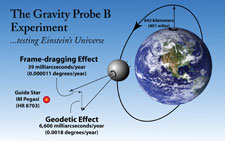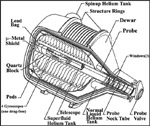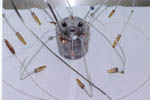WEEKLY HIGHLIGHTS FOR 15 OCTOBER 2004:
GRAVITY PROBE B MISSION UPDATE

Six months into the mission, GP-B is performing remarkably well. The spacecraft
is in fine health, flying drag-free around gyro #1. All four gyros remain digitally
suspended, and they are all generating science data. The spacecraft is rolling
at 0.7742 rpm (77.5 seconds per revolution), and all subsystems are performing
well. The Dewar temperature remains nominal at 1.82 kelvin, and the flow of
helium from the Dewar through the micro thrusters continues to be within expected
limits. We are now in our seventh week of data collection, which is going very
smoothly, and a recent test on the Dewar indicates that we have enough helium
to continue collecting data for approximately eight more months. The quality
of the data gathered thus far is excellent.

This past week has been a relatively quiet one for the GP-B spacecraft. The
oscillations in the drag-free control force, which we have been reporting on
for the past two weeks, have diminished to an insignificant level. Adjustments
that we made to the drag-free suspension parameters to de-tune a harmonic coupling
between the drag-free control system and helium sloshing in the Dewar, combined
with reducing the gain in the drag-free controller to its initial level, seem
to have mitigated this instability. To be certain, we are continuing to monitor
the drag-free control system with regards to this issue.
Furthermore, gyro #3, which we have been monitoring over the past three weeks,
since it unexpectedly transitioned from digital to analog back-up suspension,
has remained digitally suspended, without further incident this past week.
 We suspect that the issue with gyro #3 is not related to the gyro rotor (sphere)
itself, but rather with some noise spikes in its suspension system that have
exceeded pre-set limits, automatically triggering a transition into analog
back-up suspension mode. Increasing the signal-to-noise ratio of this gyro’s
position readout seems to have mitigated this problem. However, we are continuing
to monitor gyro #3, and we are still analyzing the root cause of this behavior.
We suspect that the issue with gyro #3 is not related to the gyro rotor (sphere)
itself, but rather with some noise spikes in its suspension system that have
exceeded pre-set limits, automatically triggering a transition into analog
back-up suspension mode. Increasing the signal-to-noise ratio of this gyro’s
position readout seems to have mitigated this problem. However, we are continuing
to monitor gyro #3, and we are still analyzing the root cause of this behavior.
The two issues mentioned above have prompted several inquiries about the effects
of such events on the health of our data and the ultimate results of the experiment.
 The short answer is that neither of these events has had any significant effect
on the data or the experimental results. The SQUID readouts for each gyro continue
to provide spin axis orientation data in both digital and analog suspension
modes, so no data was lost when gyro #3 transitioned to analog mode. Also,
even in those few moments when the spacecraft is not in drag-free mode, we
continue to collect data, but in this case, we must carefully evaluate any
potential torques (forces) placed on the gyros to ensure that they did not
alter the gyro’s spin axis alignment. For readers who are interested,
we will provide a more detailed explanation of our data collection process
in a future Weekly Highlights.
The short answer is that neither of these events has had any significant effect
on the data or the experimental results. The SQUID readouts for each gyro continue
to provide spin axis orientation data in both digital and analog suspension
modes, so no data was lost when gyro #3 transitioned to analog mode. Also,
even in those few moments when the spacecraft is not in drag-free mode, we
continue to collect data, but in this case, we must carefully evaluate any
potential torques (forces) placed on the gyros to ensure that they did not
alter the gyro’s spin axis alignment. For readers who are interested,
we will provide a more detailed explanation of our data collection process
in a future Weekly Highlights.
Drawings & photos: The diagrams of the GP-B experimental procedure and the cutaway drawing of the Dewar are from the GP-B Image Archives here at Stanford. Likewise, the photo of a complete gyro housing, including all of its wires and fiber optic cables and the photo of a SQUID (Super-conducting Quantum Interference Device) electronics box are also from the GP-B Image Archives. Click on the thumbnails to view these images at full size.
Please Note: We will continue updating these highlights and sending out the GP-B email update on a weekly basis—at least through the first few weeks of the Science Phase of the mission. As mission operations become more routine, we may reduce the frequency of these updates to biweekly. However, from time to time, we intend to post special reports and special updates, as warranted by mission events.
SWISS AMATEUR ASTRONOMER PHOTOGRAPHS GP-B GP-B SPACECRAFT IN ORBIT WITH GUIDE STAR IM PEGASI
To the right, is a thumbnail of a photograph of the GP-B spacecraft in orbit, along with the guide star, IM Pegasi. (Click on the thumbnail to view the photo at full size.) The photo was taken and emailed to us by Stefano Sposetti, a Swiss physics teacher and amateur astronomer. Stefano used a 40cm newtonian telescope, with a CCD camera and 20mm wide field lens attached to make this photo. He then sent us the two versions shown — the normal (black sky) version on the right, and an inverse version in which the constellation, Pegasus, the guide star IM Pegasi, and the path of the GP-B spacecraft are highlighted for easy identification on the left.

We are grateful to Stefano for sending us this wonderful photo. You can view other astronomical photos that he has taken on his Web page: http://aida.astronomie.info/sposetti. Following is Stefano's description of his photo:
In this picture one can see the quite dim GP-B satellite traveling from North (up) to South (down) direction. The bold line in the right part of the left image represents the satellite trail just before entering the earth shadow. (Every satellite becomes visible because it reflects the sunlight). The connecting lines show the constellation Pegasus. The small circle around the star is IM Pegasi, the guide star used by the spacecraft's telescope in his experiment! GP-B is a circumpolar satellite following a free fall trajectory about 640km above the earth surface. From my location the satellite passed that night at a maximum elevation of 87degrees, thus not exactly overhead. The brightness of the satellite was between 3mag and 4mag. The Moon, about in the last quarter phase, illuminated the sky and was a drawback for having a good signal/noise ratio of the satellite trace. I took this 60-seconds black and white CCD picture with a 20mm,f/2.8 lens on august 6 centered at 01:19:00 UT. North is up, East is left.
More links on recent topics
- Track the satellite in the sky
- Photo, video & and news links
- Build a paper model of the GP-B Spacecraft
- Following the mission online
- Our mailing list - receive the weekly highlights via email
- The GP-B Launch Companion in Adobe Acrobat PDF format. Please note: this file is 1.6 MB, so it may take awhile to download if you have a slow Internet connection.
Previous Highlight
Index of Highlights
